Kinematics: One dimensional motion
Physics has many branches. Mechanics is one of them. In mechanics, there are kinematics and dynamics. Kinematics is studying the motion of objects without considering the causes (forces) of the motion. So, in kinematics, you don't have to know why an object is moving and what causes its motion.One dimensional (1-D) kinematics or motion refers to the motion of objects on straight line paths. A car moving on a straight road, motion of a dropped object and the motion of a foot ball kicked vertically upwards are some of the examples of 1-D motion. When studying one dimensional motion, we do not consider the size or the shape of the object, instead we consider it as a point. The locations of the point at different times lie on a straight line in a 1-D motion.

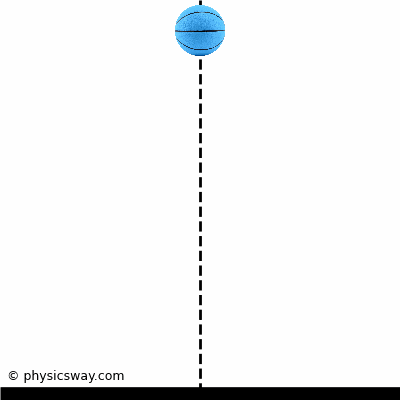
Position of an object
Position of an object is the location of the object. To locate an object we need a reference. We use the Cartesian coordinate system with three perpendicular axes, $x$, $y$, and $z$ as reference. We call this frame of reference or the reference frame.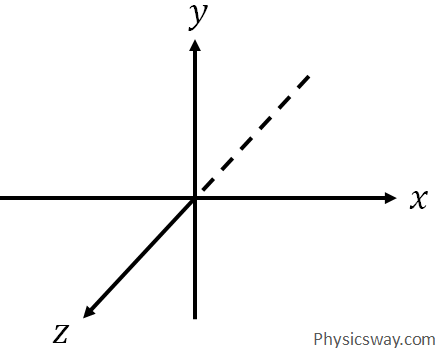
Since in a one dimensional motion, the object moves on a straight line path, we consider the path is one of the axes, usually the $x$ axis or sometimes the $y$ axis. If you consider $x$ axis is the path, then the letter $x$ represents the position of the object, and if $y$ axis is the path, then the letter $y$ represents the position. In the following figure, the position, $x$ of the blue car is 100 m. The meter (m) is the SI unit for position.
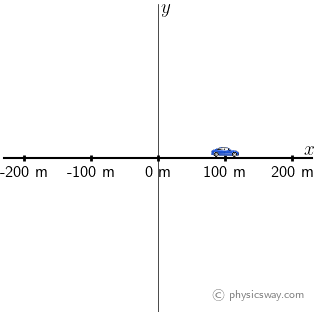
Direction of motion
In a 1-D motion, an object has only two possible directions: the positive and the negative direction. If the position (the $x$ values) of the object increases, then we say that the object is moving in the positive direction. And if the position decreases, then we say tht the object is moving in the negative direction. In the figure below, the object in red moves in the positive direction and the object in green moves in the negative direction.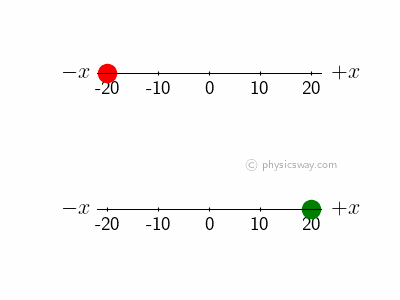
The positive direction can be any direction that we normally use in our daily life. It can be north, south , east, west or any other. It is arbitrary to choose one direction as positive and the one opposite to it as negative. If you take east as positive, then the west will be the negative direction and vice versa.
Distance and displacement
Distance and displacements are two different quantities in physics.If an object moved from a point A to another point B, the distance traveled by the object is the length of the path from A to B. There may be many available paths from A to B, of different lengths. In the figure below, there are two possible paths from A to B, a shorter path, path 1 and a longer path, path 2. If the object takes path 2, then it will travel more distance than on path 1. So, the distance depends on the path taken by the object. Since distance is a length, it is a positive number. Further, distance has no direction as the distance traveled from A to B is same as the distance from B to A on the same path. A quantity that has no direction is called a scalar, so distance is a scalar.
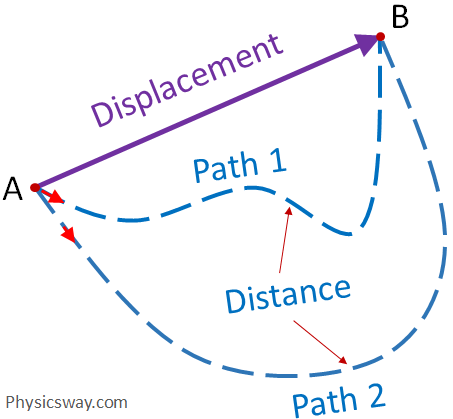
Displacement of an object is a measure of how much the object has moved or displaced from its starting point and in what direction. To find the displacement, draw a straight line with an arrow, from the initial point to the final point (see the figure above). The length of this straight line is the size of the displacement, called the magnitude of the displacement. And the arrow that points away from the initial position and towards the final position of the object, shows the direction of the displacement. So, displacement has a magnitude and a direction. Any quantity that has both magnitude and direction is called a vector, so displacement is a vector. The displacement line (the straight line with the arrow) is called the displacement vector.
Displacement is independent of the path as you only need the initial and the final positions of an object to find its displacement.
If an object makes a round trip motion and come back to the starting point, then the displacement of the object is zero. But the distance will not be zero. The distance is just the length of the loop if the object makes one round trip around the loop and twice the length if it makes two round trips.
The SI unit of distance and displacement is meter (m).
Displacement in a 1-D motion
In a 1-D motion, we can define the displacement asdisplacement, $\Delta x=x_2-x_1.$
where $x_1$ is the initial position of the object and $x_2$ is its final position.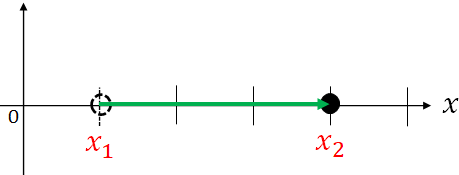
The displacement, $\Delta x$ is positive for an object moving in the positive direction as $x_2\gt x_1$ in the positive direction. And $\Delta x$ is negative for the negative direction as in that direction $x_2 \lt x_1$. So, in a 1-D motion, the sign of the displacement reflects the direction of the displacement.
Note that you cannot compare distance and displacement as a displacement has a direction but a distance has not. But you can compare the distance and the magnitude of displacement as both represent a length. Except the motion is one dimensional and in one direction, magnitude of displacement is smaller than the distance traveled by the object.
----------------------------------------Video: We have posted a more detailed video of distance and displacement with animations. Watch the video and support this website. Here is the link:
Video on distance and displacement.

Example: A car travels 5 km due east on a straight road, then turns back and travels 3 km due west. Find the distance traveled by the car and its displacement.
Solution:
Distance traveled by the car is the length of the path covered by the car. That isdistance $= 5 km + 3 km=8 km$.
The car travels on a straight road, so the motion is one dimensional. To find the displacement, we need the initial and the final position of the object. To locate the positions, put a frame of reference, and take the object's path is along the $x$ axis. And, consider the object starts from the origin (you can choose another point too). So, the initial position of the object is
$x_1=0$
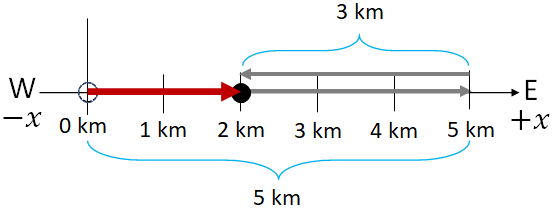
I took the east as the positive direction, so the west is the negative direction. Since choosing a direction as positive or negative is arbitrary, it doesn't matter if you take west as positive direction and the east as negative.
The object first travels $5\,km$ due east, so it ends at $x=5 km$. Then turns back and travels 3 km westward. So the final position of the object is
$x_2= 2 \,km$.
A straight line from the initial to the final position of the object with an arrow points toward the final position is the displacement vector. Since the arrow point towards the east, the direction of the displacement is eastward.
With the initial and the final position, we can find the displacement of the object.
The object's displacement is
$\Delta x = x_2-x_1= 2 km -0 = 2km$.
The displacement is a positive number, so, the direction of the displacement is positive. Since we took the east as positive direction, the direction of the displacement is eastward. This we already know from the arrow of the displacement vector.
Absolute value of the displacement is the magnitude of the displacement, which is 2 km.
So, the answers are
Distance traveled by the object $= 8 km$.
Displacement of the object is 2 km eastward (write the magnitude first, then the direction).

Speed
Speed is how fast an object is moving. To find the speed of a moving object, measure the distance the object travels over a time interval, and divide that distance by the time interval. So, speed of an object is defined as$speed=\dfrac{distance}{time}$
Speed can be instantaneous or average. Instantaneous speed is the speed at an instant of time. The odometer of your car shows the instantaneous speed, the speed of the car at the moment you look at the meter. Average speed is the speed that you determine by observing the motion of the car between two times (i.e., over a time interval), not an instant. For example, assume you drive your car for, say 10 minutes and travel a distance of 2 km. Dividing the distance by time, you get, 0.2 km/min. This speed is the average speed as it is not the speed at one time, but it is the speed determined between two times with an interval of 10 minutes.
Why we use the word average for the speed that is measured over a time interval ? Because, during the time interval, the object can have different instantaneous speeds at different times, so, what you will get is the average speed. If the object moves at a constant speed at any moment during the time interval, then the average speed will be equal to the instantaneous speed. Further, if the speed is instantaneous, then we skip the word instantaneous and just say speed.
Now, another question may arise, how can one find the instantaneous speed without having a time interval to travel some distance. Yes, you cannot travel a distance without spending some time. So, actually, the instantaneous speed shown by the odometer is not exactly instantaneous, but it is an average speed over a very small time interval around the time of ineterest, much smaller than the human response time. So instantaneous speed is actually the average speed over a small time interval. How small the time interval should be? It depends upon how quickly the object speed changes around the time of interest and also the needed accuracy.
Speed has no direction because speed is distance over time and the distance has no direction. So, speed is always positive, like distance.
----------------------------------------
Video: We have posted a video on speed. Watch the video and support this website. Here is the link: Video of Speed.
----------------------------------------Velocity
Like speed is related to distance and time, there is another quantity, called velocity that relates displacement and time.If an object object makes a displacement, $\Delta x$ in a time interval $\Delta t$, then the velocity of the object is
$\bar v=\dfrac{\Delta x}{\Delta t}$
where $\bar v$ is the average velocity. We call this velocity the average as it is the velocity over a time interval of two different times, not at an instant of time. The bar over the letter $v$ represents the average.If $t_1$ is the initial time and $t_2$ is the final time, then $\Delta t=t_2-t_1$. Note that $\Delta t$ is always a positive number as time never decreases ($t_2>t_1)$.
Instantaneous velocity is the velocity at a single instant of time, which is actually the velocity over a small time interval. We write the instantaneous velocity as $v$ without the bar. Note that if you just say velocity, which represents the instantaneous velocity.
Velocity is a measure of how the position of an object changes per unit time. If we use the SI units, then the velocity of an object tells us how many meters the object's position changes every second.
Since displacement is a vector, and velocity is displacement over time, velocity is a vector. Direction of velocity is the direction of the object's displacement, which is the direction of motion of the object. In a 1-D motion, the velocity is positive if the object is moving in the positive direction and is negative if the motion is in the negative direction. For example, if you take the north as positive direction and the object is moving due south, then the velocity will be negative.
Note that, the magnitude of average velocity is not always the same as the average speed. If an object travels on a straight path in one direction, then the magnitude of average velocity is same as the average speed. But if the object travels back and forth on a straight path or it moves on a curved path, during the desired time interval, then the magnitude of average velocity will be smaller than the average speed.
When an object is in motion, it needs some time to change its direction. So, you can realize that for a sufficiently small time interval, all objects move on a straight line path in one direction. Therefore, in a small time interval, the magnitude of average velocity of an object is its speed. Since the average velocity over a small time interval is the instantaneous velocity, the magnitude of the instantaneous velocity is just the speed of the object.
You can show that the velocity of an object is the slope of the position versus time graph as follows.

In the figure above, the position of a moving object at different times is graphed. Let us consider the motion of the object over a time interval from $t_1$ to $t_2$. $x_1$ and $x_2$ are the positions of the object at $t_1$ and $t_2$ respectively. If you draw a line between the points $(t_1, x_1)$ and $(t_2, x_2)$ and find the slope of the line, you will get
slope $=\dfrac{x_2-x_1}{t_2-t_1}$
$=\dfrac{\Delta x}{\Delta t}$
$=\bar v$
Thus, the slope of the line drawn between any two points corresponding to two times is just the average velocity over the time interval between those times. Now, the question is suppose if you take an instant of time, then how the velocity is related to the slope? If you take only one time, then the slope of the tangent drawn at the point corresponding to the time will be the velocity at that time. So, velocity is just the slope of a position versus time graph.
As an example, an object's position ($x$) versus time, ($t$) is given below. I have selected four points A, B, C and D corresponding to 4 different times. The tangents at the points A, B, C and D are shown. Velocity of the object at a time is the slope of the tangent at the point corresponding to that time. i.e., the velocity of the object at $t=2s$ is the slope of the tangent at A.
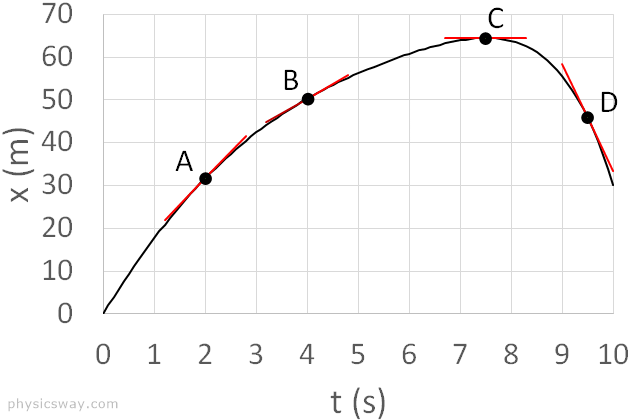
Slope of the tangents at A and B is positive; the slope of the tangent at C is zero (as the tangent is a horizontal line). So, the velocities at $t=2s$ and at $t=4s$ are positive, and at $t=7.5s$, the velocity of the object is zero. The slope of the tangent at D is negative. Therefore, at $t=9.5 s$, the velocity is negative. Based on these we can conclude that the object is moving in the positive direction up to the point C and it stops there, then turns back and move in the opposite direction (negative direction).
Acceleration
When the speed of a car is increasing, we say that the car is being accelerated. And if the car slows down, we say the car is decelerating. In both the cases, the velocity of the car changes. In physics, we say there is an acceleration whenever there is a change in velocity of the object.Acceleration of an object is defined as
acceleration $=\dfrac{change\:in\:velocity}{time}$
If in a time interval, $\Delta t$, the velocity of an object changes from $v_1$ to $v_2$, then the acceleration of the object is
$\bar a=\dfrac{\Delta v}{\Delta t}$where $\bar a$ is the average acceleration, $\Delta v = v_2 - v_1$ is the change in velocity. We call, $v_1$, the initial velocity and $v_2$, the final velocity.
Like velocity, acceleration can be average $(\bar a)$ or instantaneous $(a)$.
Acceleration is a measure of how the velocity changes per unit time. In SI units, acceleration tells us how much the velocity changes every second. For example, an acceleration (magnitude) of $7 m/s^2$ means, every second the speed of the object increase or decrease by $7 m/s$.
We can show that in a velocity versus time graph (with time $t$ on the $x$-axis and the velocity, $v$ on the $y$-axis) of an object, the slope of the graph is the acceleration of the object. This is same as showing velocity as a slope in a position versus time graph.

Since velocity is a vector, and the acceleration is change in velocity over time, acceleration is also a vector. In a 1-D motion, acceleration and velocity of an object are in the same direction if the object is speeding up, but if the object is slowing down, they are in the opposite directions. We can prove these by considering the following.
Assume an object is moving in the positive direction at some speed, say $3 m/s$. This speed is the instantaneous speed, which is the magnitude of velocity. The object is accelerated for, say $1 s$ so that the speed at the end of $1 s$ is say $5 m/s$. Since the object is moving in the positive direction, the initial and the final velocities are positive:
$v_1= 3 m/s$ and $v_2= 5 m/s$
So the acceleration of the object is
$a=\dfrac{ v_2-v_1}{\Delta t}$
$= \dfrac{5 m/s-3 m/s}{1 s} = + 2 m/s^2$
Acceleration and the velocity both are positive, so they are in the same direction.
Now, let us consider the object is moving in the negative direction with some speed, say $2 m/s$ and is accelerated to a speed of say $6 m/s$ over a time period of $1 s$. Since the object is moving in the negative direction, the velocities are negative:
$v_1= - 2m/s$ and $v_2= -6 m/s$.
Finding the object's acceleration,
$a=\dfrac{v_2-v_1}{\Delta t}$
$= \dfrac{-6 m/s -(-2 m/s)}{1 s} = - 4 m/s^2$
Here again, the acceleration and the velocity are in the same direction as both are negative.
Now, let us consider the object is moving in the positive direction but slowing down. As the object slows down, its final speed is smaller than the initial speed. Assume the initial speed is say $6m/s$ and the final speed as $3 m/s$. And take $\Delta t = 1 s$. Since the motion is in the positive direction, we have
$v_1 = 6m/s$ and $v_2 = 3m/s$
The acceleration of the object is
$a=\dfrac{3 m/s - 6 m/s}{1 s}=- 3 m/s^2$
The acceleration is negative, and the velocity is positive, so they are in the opposite directions. You will get the same result if you take the object is moving in the negative direction. So, when an object is slowing down, the acceleration and the velocity are in the opposite directions.
It is important to note that the sign of acceleration depends on two things, the sign of the velocity (i.e., the direction of motion) and whether the object is speeding up or slowing down. So, a negative acceleration of an object does not always mean the object is slowing down or a positive acceleration does not always mean the object is speeding up.
1-D kinematic equations
In a 1-D motion, we will mostly deal with constant acceleration. When the acceleration of an object is constant, its average acceleration over a time interval will be same as the instantaneous acceleration at any instant of time during that time interval. It is like taking the average of same numbers: average of same numbers is one of the number.For constant acceleration,$a$, we can have a set of four equations that relate the time, and the object's displacement, velocity and acceleration. These equations are called 1-D kinematic equations. Derivations of these equations are given in a separate page: deriving the kinematic equations.
Following are the 1-D kinematic equations:$v=v_0+at$
$\Delta x=\dfrac{1}{2}(v_0+v)t$
$\Delta x=v_0t+\dfrac{1}{2}at^2$
$v^2 = v_0^2 + 2a \Delta x$
In the 1-D kinematic equations, $t=0$ is the initial time, and $t$ is the time interval between the initial and the final time. For example, if $t = 2 s$ means, $2 s$ has passed since the object's motion started. $v_0$ is the initial velocity that is the velocity at $t=0$; $\Delta x$ and $v$ are respectively the displacement and velocity at time $t$.Free fall motion
Isaac Newton is an English physicist, discovered gravity in the 1680s. He found that objects are attracted toward the earth by gravity.That is why if you drop or throw an object, it finally comes down instead of going up. But long before Newton, Galileo Galilei, an Italian astronomer and a physicist, discovered that when there is no air resistance, all objects fall with same acceleration irrespective of their masses. i.e., if you drop a $1 kg$ object and a $10 kg$ object at the same time from same height, both will hit the ground at the same time.
But if you simultaneously drop a feather and a rock from the same height, you can see that they do not reach the ground at the same time. The rock reaches the ground earlier than the feather. This is because of the air resistance. Air resistance dominates the feather due to its larger surface area per unit mass than the rock. But if you take the feather and the rock inside of a long evacuated cylindrical container, and drop them, then both will hit the bottom at the same time.
An object in motion above the earth's surface that is only under the influence of earth's gravity is said to be in free fall. But a moving object in air has air resistance acting on, in addition to gravity. We can ignore the air resistance in most cases except the objects like a feather or a piece of paper. So, ignoring the air resistance, any object that you drop or throw into the air is called a freely falling object and the motion of such an object is called free fall motion. In all cases, that we will deal with in this section, we will ignore the air resistance.
If you drop an object or throw an object exactly vertically upward or downward, you can see that the object follows a straight line with respect to the earth. For example, if you throw a ball vertically upward, it will come back to the exact point from where it was thrown. So the motion of such an object (dropped or thrown vertically upward/downward) is one dimensional. We will focus on the 1-D free fall motion in this section.
Let us see what happens if you throw an object vertically upward. The animation above, shows the motion of a ball thrown vertically upward with some initial velocity. The green arrow represents the velocity and the blue arrow, the acceleration of the ball. You can see that the speed (magnitude of velocity) of the ball decreases as it goes up, then, it stops at some point, and comes down. While the ball is coming down, its speed increases. Whether the object is going up or coming down, you can find that the acceleration of the object is always downwards. This is because, when the object is going up, the speed decreases so the acceleration is opposite to the direction of motion, which is downward. When the object is coming down, the speed of the object increases so the acceleration is in the same direction as the direction of motion, which is downward. Thus the acceleration always point downwards.
Acceleration of a freely falling object is called acceleration due to gravity. We will use the letter $g$ to represent the magnitude of the acceleration due to gravity. If you measure the acceleration of a free fall object near the surface of the earth, you will get, $g=9.80 m/s^2.$ This value is constant unless you go too far from the earth's surface.
Since the acceleration due to gravity is constant near the surface of the earth, we will use the 1-D kinematic equations to describe the 1-D free fall motion. Since the motion is vertical (vertical to the earth's surface), we take the path of the object along the $y$ axis. So, we use the variable $y$ for the object's position and $\Delta y$ for the object's vertical displacement. Following are the equations we use to study the free fall motion.
$v = v_0 +a t $
$\Delta y = v_0 t + {1\over 2} a t^2 $
$v^2 = v_0^2 + 2a \Delta y$
Since, choosing a direction as positive or negative is arbitrary, we can choose upward as positive direction or downward as positive direction.
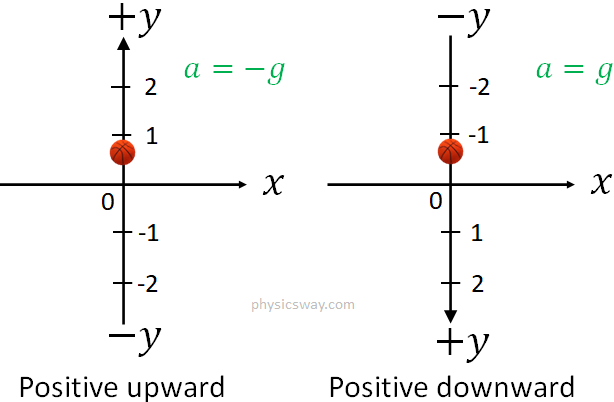
If you choose the positive upward, then the acceleration of the object will be negative as the acceleration due to gravity is downward. So, you need to substitute, $a=-g$ in the above equations.
And, if you choose the positive downward, then the acceleration will be positive, so substitute $a=g$ in the equations.
When solving problems, look for, in which way the object is moving initially: upward or downward. If the object is moving upward, take the upward as positive. If the object is moving downward, then take downward as positive direction.
